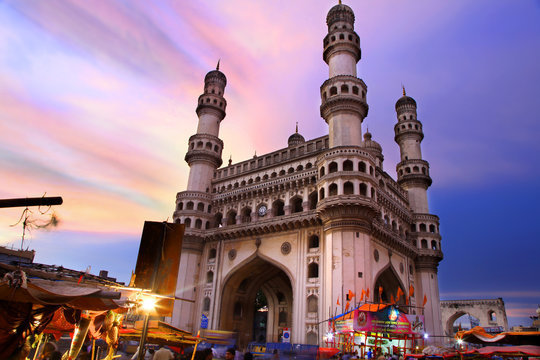
Charminar
The Iconic Monument of Hyderabad
| Location | Pathergatti, Char Kaman, Ghansi Bazaar, Hyderabad, Telangana 500002, India |
|---|---|
| City | Hyderabad |
| Country | India |
| Coordinates | 17.3616°N 78.4747°E |
| Architect | Qutb Shahi Dynasty (believed to be designed by Muhammad Quli Qutb Shah) |
| Construction Started | 1591 |
| Completed | 1592 |
| Historical Significance | A historic and architectural landmark of Hyderabad, representing its rich heritage and culture. |
The History of Charminar
Charminar is a historical monument located in the heart of Hyderabad, Telangana, India. It was built in 1591 by the fifth ruler of the Qutb Shahi dynasty, Sultan Muhammad Quli Qutb Shah, as a symbol of the city's foundation and a tribute to the eradication of a plague that had gripped the city.
The name "Charminar" is derived from two Urdu words, "Char," meaning four, and "Minar," meaning tower. The monument features four grand arches, each facing a cardinal direction, and it has four intricately designed minarets. Charminar is a fine example of Indo-Islamic and Persian architectural styles, with influences from the Qutb Shahi dynasty's rich cultural heritage.
Over the centuries, Charminar has become a cultural and historical icon of Hyderabad. It stands as a symbol of the city's vibrant past and its unique blend of traditions. The monument's significance extends beyond its architectural beauty; it represents the unity and diversity of the people of Hyderabad and their rich heritage.
Today, Charminar is not only a popular tourist attraction but also a bustling marketplace, surrounded by vibrant shops and local vendors. It continues to be a center of cultural and social gatherings, making it a lively and dynamic part of the city's fabric.
In conclusion, Charminar is more than just a historic monument; it is a living testament to the spirit of Hyderabad, its rich culture, and the enduring legacy of the Qutb Shahi dynasty.
Facts About Charminar
- Charminar is located in Hyderabad, Telangana, India.
- It was constructed in 1591 by Sultan Muhammad Quli Qutb Shah, the fifth ruler of the Qutb Shahi dynasty.
- The name "Charminar" means "four minarets" and refers to the monument's distinctive architectural features.
- Charminar is an excellent example of Indo-Islamic and Persian architectural styles.
- It was built to commemorate the end of a plague that affected the city and to mark the foundation of Hyderabad.
- The monument has become a symbol of Hyderabad's rich heritage and cultural diversity.
- Charminar remains a vibrant part of the city, hosting a lively marketplace and social gatherings.
- It is an enduring symbol of unity, culture, and history for the people of Hyderabad.